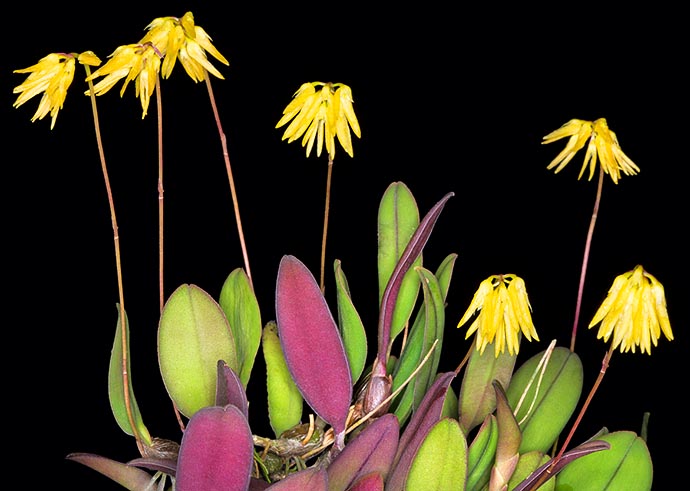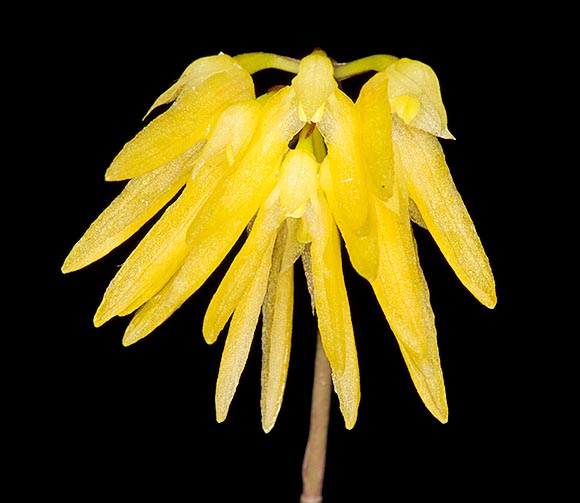Family : Orchidaceae

Text © Pietro Puccio

English translation by Mario Beltramini

Bulbophyllum purpurascens is a South-East Asian miniature epiphyte. Ovoid pseudobulbs spaced of 3-4 cm on creeping rhizome, having only one oblong-elliptic leaf with obtuse apex tending to purple on the lower page © Giuseppe Mazza
The species is native to Borneo, Java, Malaysia, Sumatra and Thailand where it grows as epiphyte in the humid forests, often along the banks of the water streams, up to about 1500 m of altitude.
The name of the genus is the combination of the Greek terms “βολβός” (bolbos) = bulb and “φύλλον” (phyllon) = leaf, with reference to the leaves growing at the apex of the pseudobulbs; the name of the species is the Lain adjective “purpurascens” = tending purple, with reference to the colour of the lower page of the leaves.
Bulbophyllum purpurascens Teijsm. & Binn. (1862) is an epiphytic species with ovoid pseudobulbs spaced of 3-4 cm on a creeping rhizome, 1-2 cm long and 0,7-1 cm broad, provided at the apex of only one oblong-elliptic leaf with obtuse apex, 3-7 cm long and 1-3,5 cm broad, rigid, fleshy, of dark green colour with violaceous purples margin above, violaceous purple below. Inflorescence from the base of the pseudobulb 6-18 cm long and carrying 8-18 drooping, close, flowers, white to pale yellow. Ovate dorsal sepal with pointed apex, about 0,5 cm long, lateral sepals, the most showy part of the flower, oblong-linear, 1,2-1,8 cm long, ovate-lanceolate petals with pointed apex, about 0,4 cm long, lanceolate curved labellum, fleshy, about 0,3 cm long.

The decidedly unusual inflorescence carries 8-18 close drooping flowers © Giuseppe Mazza
The flowers are short-lasting, 3-5 days.
It reproduces by seed, in vitro, and at amateurish level, by division, with each section provided of at least 3-4 pseudobulbs.
Miniature orchid, requires a semi-shaded position, medium-high temperatures, 18-30 °C, high humidity, 70-85%, accompanied by constant ventilation to minimize the risk of fungal attacks. It needs regular waterings and nebulisations in order to maintain constantly humid the substratum, but without stagnations, utilizing rainwater, demine- ralised or by reverse osmosis.
Fertilizations during the growth period with hydrosoluble balanced products, with micro- elements, at ¼ of the dosage suggested by the producer, duly alternated with the waterings for avoiding salts accumulations at the roots.
It is usually mounted on branches, bark, rafts of cork or of arborescent ferns, in way to allow the rhizome to freely elongate; the roots are thin and delicate and consequently are to be disturbed only when strictly necessary.
The species is listed in the appendix II of the CITES (species whose trade is internationally ruled).
Synonyms: Cirrhopetalum lendyanum Rchb. f. (1887); Phyllorchis purpurascens (Teijsm. & Binn.) Kuntze (1891); Phyllorkis purpurascens (Teijsm. & Binn.) Kuntze (1891); Cirrhopetalum peyerianum Kraenzl. (1893); Cirrhopetalum compactum Rolfe (1895); Cirrhopetalum citrinum Ridl. (1896); Bulbophyllum curtisii Ridl. (1898); Bulbophyllum perakense Ridl. (1898); Cirrhopetalum pallidum Schltr. (1906); Bulbophyllum citrinum (Ridl.) Ridl. (1907); Bulbophyllum tenasserimense J.J.Sm. (1912); Bulbophyllum rhizophoreti Ridl. (1924); Bulbophyllum peyerianum (Kraenzl.) Seidenf. (1974).
→ For general notions about ORCHIDACEAE please click here.
